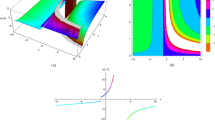Abstract
An efficient numerical method is described for solving partial differential equations in problems where traditional eulerian and lagrangian techniques fail. The approach makes use of the geometrical concept of 'natural neighbours', the properties of which make it suitable for solving problems involving large deformation and solid–fluid interactions on a deforming mesh, without the need for regridding. The approach can also be applied to high-order partial differential equations (such as the Navier-Stokes equation), even in cases where the evolving mesh is highly irregular.
This is a preview of subscription content, access via your institution
Access options
Subscribe to this journal
Receive 51 print issues and online access
$199.00 per year
only $3.90 per issue
Buy this article
- Purchase on Springer Link
- Instant access to full article PDF
Prices may be subject to local taxes which are calculated during checkout
Similar content being viewed by others
References
Roache, P. J. Computational Fluid Dynamics (Hermosa, Albuquerque, NM, 1982).
Zienkiewicz, O. C. The Finite Element Method 3rd edn (McGraw-Hill, Maidenhead, 1977).
Zienkiewicz, O. C. & Phillips, D. V. Int. J. num. Meth. Engng 8, 519–528 (1971).
Bathe, K.-J., Ramm, E. & Wilson, E. L. Int. J. num. Meth. Engng 9, 353–386 (1975).
Sibson, R. Math. Proc. Camb. phil. Soc. 87, 151–155 (1980).
Voronoi, M. G. J. reine angew. Math. 134, 198–287 (1908).
Delaunay, B. N. Bull. Acad. Sci. USSR: Class. Sci. Math. 7, 793–800 (1934).
Fortune, S. in Computing in Euclidean Geometry (eds Du, D. Z. & Hwang, F.) (World Scientific, Singapore, 1992).
Barber, B., Dobkin, D. P. & Huhdanpaa, H. Technical Rep. GCG53 (The Geometry Centre, Univ. Minesota, Minneapolis, 1993).
Fortune, S. Algorithmica 2, 153–174 (1987).
Braun, J. & Sambridge, M. Earth planet Sci. Lett. 124, 211–220 (1994).
Sibson, R. in Interpreting Multivariate Data (ed. Barnet, V.) 21–36 (Wiley, Chichester, 1981).
Watson, D. F. Contouring: a Guide to the Analysis and Display of Spatial Data (Pergamon, Oxford, 1992).
Finlayson, B. A. The Method of Weighted Residuals and Variational Principles (Academic, New York, 1972).
Sambridge, M., Braun, J. & McQueen, H. Geophys. J. int. (In the press).
Lasserre, J. B. J. Opt. Theory Applic. 39, 363–377 (1983).
Bathe, K.-J. Finite Element Procedures in Engineering Analysis (Prentice-Hall, Englewood Cliffs, NJ, 1982).
Van Norton, R. in Mathematical Methods for Digital Computers Vol. 1 (eds Ralston, A. &Wilf, H. S.) (Wiley, New York, 1960).
Hughes, T. J. R., Winget, J., Levit, T. & Tedzuyar, T. E. in Computer Methods for Non-linear Solids and Structure (eds Atluri, S. N. & Perrone, N.) 75–109 (Am. Soc. Mech. Eng., New York, 1983).
Batchetor, G. K. An Introduction to Fluid Dynamics (Cambridge Univ. Press, 1967).
Fung, Y. C. Foundations of Solid Mechanics (Prentice-Hall, Englewood Cliffs, NJ, 1965).
Author information
Authors and Affiliations
Rights and permissions
About this article
Cite this article
Braun, J., Sambridge, M. A numerical method for solving partial differential equations on highly irregular evolving grids. Nature 376, 655–660 (1995). https://doi.org/10.1038/376655a0
Received:
Accepted:
Issue Date:
DOI: https://doi.org/10.1038/376655a0
This article is cited by
-
Concurrent semi-Lagrangian reproducing kernel formulation and stability analysis
Computational Mechanics (2024)
-
FEM and Experimental Analysis of Lunar Soil Excavation Test
KSCE Journal of Civil Engineering (2023)
-
The Radial Point Interpolation Method combined with a bi-directional structural topology optimization algorithm
Engineering with Computers (2022)
-
Topology optimization of light structures using the natural neighbour radial point interpolation method
Meccanica (2022)
-
Three-dimensional strain descriptors at the Earth’s surface through 3D retrieved co-event displacement fields of differential interferometric synthetic aperture radar
Journal of Geodesy (2021)
Comments
By submitting a comment you agree to abide by our Terms and Community Guidelines. If you find something abusive or that does not comply with our terms or guidelines please flag it as inappropriate.



